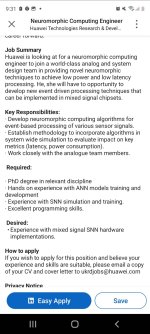cosors
👀
Thank you very much for your overview and for your tireless work!I think he or she is on safe ground saying this as they use entirely different approaches and systems so are not compatible one with the other. Put'em together and what have you got? A mess. No bipperty bobbity boo.
But @DingoBorat there have been a number of publications including from the US Defence Department pointing out the shortfalls with these two different technologies and even this morning the post put up by @Rocket577 included a paper out of IMEC which had the following to say:
II. COMPARISON WITH OTHER DIGITAL NEUROMORPHIC
PL ATFORMS
To the best of our knowledge, the SpiNNaker architecture
[3] is a closest neuromorphic platform to SENeCA. SpiNNaker
contains several ARM cores as the processing units connected
through an advanced single router star-type multicasting asyn-
chronous packet-switched network. SpiNNaker2 [4] added
several accelerated arithmetic processing units and advanced
power management techniques in the GF22nm technology
node. On the contrary, SENeCA uses one of the smallest open-
source RISC-V processors as the controller (not used for event
processing) together with optimized accelerators and a low-
overhead mesh-type multicasting NoC (with reduced func-
tionality compared to SpiNNaker) for sparse parallel event-
based computation. Unlike SpiNNaker which is designed for
the simulation of brain-inspired research, the primary purpose
of SENeCA is to have both the hardware and software open
for optimizations and innovations in the EdgeAI neuromorphic
computation.
On the other hand, IBM TrueNorth [5] uses a plain mesh
packet-switched network (uni-cast) but with optimized (inflex-
ible) processing cores. Each core in the TrueNorth architecture
emulates exactly 256 neurons. Each neuron has 256 input
synapses, organized in a crossbar architecture, with a single
output axon connected to 256 neurons in another core. This
optimized processing core resulted in a power-efficient neuron
update (about 26pJ). µBrain [6] goes further in optimized
processing core and allows for ultra-low-power application-
specific IP (in contrast with the multi-purpose neuromorphic
processor).
In Intel Loihi [7], the processing cores are more flexible than
TrueNorth, and the interconnect is a simple uni-cast packet-
switched mesh. Also, Loihi cores accelerate a bio-inspired
learning algorithm. The cost of this flexibility is having a
higher neuron update energy (about 80pJ) in comparison
with the TrueNorth (while using a better technology node).
Loihi2 [8] scaled up the Loihi chip by packing more neurons
and synapses in a die, using the Intel4 technology node.
Additionally, it introduced programmable neurons with micro-
code, a feature also available in SENeCA. Both Loihi chips
accelerate a specific kind of bio-inspired learning mechanism
on-chip."

(PDF) SENeCA: Scalable Energy-efficient Neuromorphic Computer Architecture
PDF | SENeCA is our first RISC-V-based digital neuromorphic processor to accelerate bio-inspired Spiking Neural Networks for extreme edge applications... | Find, read and cite all the research you need on ResearchGatewww.researchgate.net
The other thing to note about IBM's True North is it makes no claims to having application at the Edge that is not the territory it is trying to mark out for itself and still maintains it is in research.
Intel's Loihi 1 & 2 are continuously described as only research chips and in the latest release from Intel posted here Intel has stated recently that they are still to identify a use case for Loihi and it may never be produced as a commercial chip and be utilised in the cloud.
If someone wants to use a neuromorphic commercial chip off the shelf at the edge the three major players SpinNaker, IBM and Intel having nothing available in their catalogue so they are compelled to look elsewhere. Brainchip's AKIDA is the undisputed most versatile neuromorphic edge chip on the market today and can also be bought as IP.
Blind Freddie just cannot believe that the sighted people cannot see the bleeding obvious particularly when the following is there in public view for all to see:
1. Nvidia is partnered with Mercedes
2. Brainchip is partnered with Mercedes
3. SiFive is partnered with Nvidia for RISC-V
4. Brainchip is partnered with SiFive to bring Ai to RISC-V
5. Brainchip is partnered with MegaChips for automotive
6. Brainchip’s Rob Telson stated in answer about competing with Nvidia that they see Nvidia more as a partner in the future
7. Nviso is partnered with Brainchip
8. Nviso is working in robotics and is partnering with Brainchip specifically for this purpose
9. Nviso is partnered with Panasonic for robotics
10. MegaChips is also partnered with Brainchip for Industrial Robotics.
11. Brainchip is partnered with Valeo
12. Valeo is partnered with Mercedes for LiDAR
13. Valeo is partnered with Honda for LiDAR
Personally I do not believe anyone knows anymore than we do.
I believe they are just starting to catch up.
My anonymous opinion only so DYOR
FF
AKIDA BALLISTA
I've only been with BRN since November and with the huge flow of information here it's hard for me to keep track of everything, including how things are connected.
Thanks to all of you who contribute so much! I miss the other side zero and feel like a fish in water on tse. A good friend will soon follow.
My thanks of course also @zeeb0t!
...I have made BRN my strongest position in the last few days






